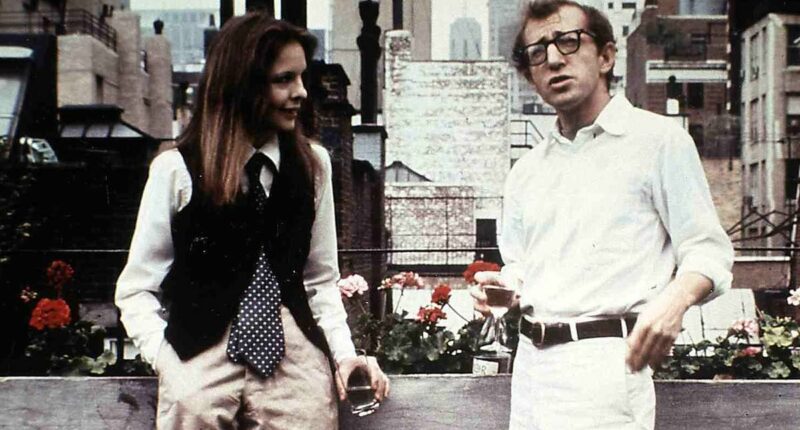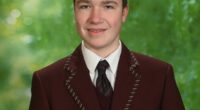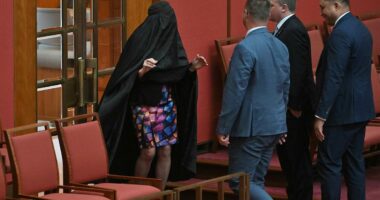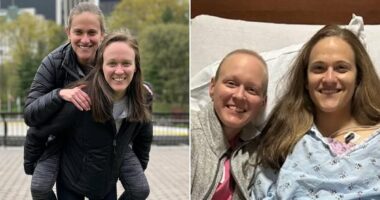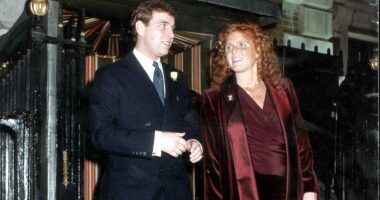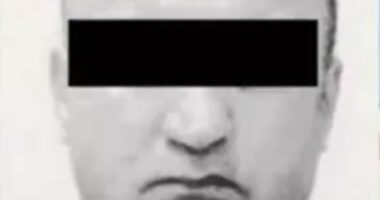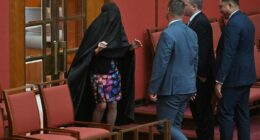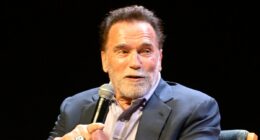Share this @internewscast.com
She was known for her stellar performances and award-winning on-screen earnest; but when the cameras stopped rolling, Diane Keaton’s influence was just as legendary, especially when it came to fashion.
The actress, who passed away this weekend aged 79, leaves behind a poignant sartorial legacy, filled with statement hats, a penchant for menswear and a founding membership of the ‘coastal grandma aesthetic’.
Mixing fitted skirts with loose blouses, adding a bowtie and suspenders to flowy culottes – the star’s looks were accentuated by uniquely blending the feminine and masculine to create a chic ensemble.
It’s always been a passion of Diane’s, who got into clothing from a young age, by thrifting with her mother.
‘She took me to Goodwill and let me express myself,’ she told PEOPLE in 2024.
‘She was my biggest supporter and manifester of my creativity. Later in life my inspiration came from countless hours of cutting and pasting my way through magazines like Vogue magazine.’
Diane carved out a name in showbiz in the 70s, most notably by playing Michael Corleone’s second wife Kay in Francis Ford Coppola’s Godfather films.
But it was 1977 that many site as her first foray into the world of being a ‘style icon’, playing the eponymous Annie Hall opposite Woody Allen.

Diane carved out a name in showbiz in the 70s, most notably by playing Michael Corleone’s second wife Kay in Francis Ford Coppola’s Godfather films. But it was 1977 that many cite as her first foray into the world of being a ‘style icon’, playing the eponymous Annie Hall opposite Woody Allen.
The film is still remembered, in part, for her stunning outfits, which included plaid shirts tucked into tailored high waist trousers, vests over turtlenecks and tinted shades.
Much of the clothing in the movie was from Diane’s own wardrobe, too.
‘In the 1970s, I was finding my style and slowly finding my career,’ she wrote in her book, Fashion First. ‘Though The Godfather was a huge success, it didn’t exactly put me on the map in terms of fashion.
‘I look back on Annie Hall and can’t talk about that movie without talking about the fashion, it was everything to me. I loved being able to dress like myself.
‘My muses were the women of New York City who were walking the streets of Soho in baggy trousers and a blazer. I was layering pieces.’
Throughout the 80s, her style began to evolve into the trends of the time, mixed with her fondness of the past decades collars, layers and flares.
‘By 1990, I began to wear a lot more suits and also found an obsession with cross necklaces, typically layered upon one another like a very devoted nun,’ she shared. ‘I also threw in some bow ties and pocket squares.’
When it came to the 2000s – by which point Diane was in her 50s and still inspiring new trends – she remarked, it was an ‘accumulation’ of all she had learned.

Mixing fitted skirts with loose blouses, adding a bowtie and suspenders to flowy culottes – the star’s looks were accentuated by uniquely blending the feminine and masculine to create a chic ensemble

It’s always been a passion of Diane’s, who got into clothing from a young age, by thrifting with her mother. Pictured in 2023


When it came to the 2000s – by which point Diane was in her 50s and still inspiring new trends – she remarked, it was an ‘accumulation’ of all she had learned

Crucial to Diane’s looks were her accessories – be it chunky jewellery, eyewear or, of course, her myriad of hats, the latter of which she had about 40 of, crediting her obsession to 1940s actor Cary Grant. Pictured in 2018

It was during this era, she explained, that her love for black and white emerged as she ‘toned down the colours’. Pictured in 2007


And despite it at times drawing mixed reactions, fashion was important to Diane as a way to feel at peace – and protect her privacy

When asked how it felt to be seen as an ‘icon’ in the world of fashion by Vogue , Diane gushed: ‘It’s an honor!’ Pictured in 1978 with Warren Beatty
It was during this era, she explained, that her love for black and white emerged as she ‘toned down the colours’.
Crucial to Diane’s looks were her accessories – be it chunky jewellery, eyewear or, of course, her myriad of hats, the latter of which she had about 40 of, crediting her obsession to 1940s actor Cary Grant.
‘I started wearing hats as soon as I realised I hated my hair. A hat allows me to hide the worst part of the head,’ the actress once said. ‘You know, that strange area from your eyebrows to your hairline. A hat is the final touch to a great outfit.’
It’s not to say that while experimenting with fashion, Diane didn’t draw any criticism – and has herself poked fun at style ‘blunders’ over the years.
In 2023, she shared three photos that sparked fierce backlash, including a 2019 premiere, which saw her accessorise a plaid-print suit with dozens of silver cross necklaces.
Another throwback photo showed the actress at an event, sporting a flowy, green polka dot dress, teamed with a white hat and matching ivory shoes.
Elsewhere, Diane for another event had opted for a maxi skirt with a chunky leather jacket pseudo-cinched at the waist with a chunky belt.
And despite it at times drawing mixed reactions, fashion was important to Diane as a way to feel at peace – and protect her privacy.

Diane in 1978 would claim the Best Actress in a Leading Role award for her work in Annie Hall, her first of four lifetime nominations. Pictured in Father of the Bride

The actress leaves behind an amazing legacy in Hollywood, with some of her performances in the 1970’s hailed as the decade’s best. Pictured in The First Wives Club

She would also receive nods for her work in movies such as 1981’s Reds, 1996’s Marvin’s Room and 2003’s Something’s Gotta Give (pictured)
‘A coat is perfection,’ she once admitted. ‘It is like a cellar. I am hidden. I can relax in a coat, which is a blessing for a person like me who tends to be anxious and worried most of the time.
‘A coat gives me the opportunity to make my own decision about how my waist will look. I lock myself in with a nice big belt.’
The same logic followed her penchant for suits.
‘The pants don’t have to be too tight,’ she explained. ‘Neither does the jacket. I like my sleeves to go down long, to cover me up. Suits make me feel comfortable.’
When asked how it felt to be seen as an ‘icon’ in the world of fashion by Vogue, Diane gushed: ‘It’s an honor! Why me? I’ve been so fortunate and lucky. And I do love clothes; I love looking at them.
‘I buy all the magazines, and I’m constantly cutting pages of things that I find interesting – a Dior outfit, hats, or how people decorate their homes. I’m an addict.’
Fashion experts have shared that Diane’s lasting style remains influential because it’s personal – not ‘performative’.
‘She cultivated a visual identity that mirrors her confidence, individuality, and wit,’ said Angela Kyte, a luxury stylist and psychotherapist.
‘Her signature look of structured tailoring, wide-brimmed hats, and monochromatic palettes reflected a woman who knows herself and dressed with intent.
‘There’s a psychological power in her consistency; it told the world she’s not here to blend in but to express authenticity through every layer of fabric.’
She added that, in particular, Diane’s aesthetic ‘rejected the fleeting nature of fashion trends’.
‘Instead, she’s built a wardrobe of self-expression anchored in comfort and character. Where others follow seasonal cycles, Diane Keaton remains timeless because she dressed from a place of self-awareness rather than conformity,’ she shared.
‘She’s proof that style becomes iconic not through extravagance, but through alignment with one’s inner identity.’
Diane also helped move fashion forward with her ‘liberating refusal to adhere to “age-appropriate” dressing’.
‘She embraced masculine silhouettes, oversized tailoring, and layering, styles often considered unconventional for women over a certain age and wore them with unapologetic grace,’ the expert added.
‘That quiet defiance has made her not just a fashion muse, but a symbol of freedom and individuality for women everywhere.’
Elsewhere, Oriona Robb said that Diane had the ‘extraordinary ability to turn simplicity into statement’.
‘Her devotion to crisp shirts, full skirts, waistcoats, and tailored trousers created a look that’s both artistic and intelligent,’ she explained.
‘She understood proportion and balance better than anyone, her style was architectural, composed, and endlessly distinctive. Every outfit felt like a masterclass in understated drama.
‘What set her apart was her fearlessness. She broke every conventional rule, mixing masculine and feminine, playing with exaggerated shapes, and embracing head-to-toe monochrome when everyone else is chasing colour trends.
‘Her wardrobe wasn’t about decoration; it was about conviction. That level of commitment to one’s aesthetic is incredibly rare and incredibly powerful.’
The star’s style endures, Oriona added, because it ‘came from within’.
‘She was not trying to look younger, trendier, or more glamorous; she was simply being Diane,’ the expert continued.
‘That quiet confidence, that refusal to apologise for standing out, is what made her an icon. In a world of fast fashion and constant reinvention, her authenticity was the ultimate luxury.’
Diane’s death was followed by emotional statements from Hollywood stalwarts such as Leonardo DiCaprio, Bette Midler, Francis Ford Coppola and a host of others.
Leonardo called the Oscar-winning star ‘brilliant, funny and unapologetically herself,’ adding that ‘she will be deeply missed’.
Bette, meanwhile, said: ‘She was hilarious, a complete original, and completely without guile, or any of the competitiveness one would have expected from such a star. What you saw was who she was…oh, la, lala!’
The Godfather director Coppola said in an Instagram post, ‘Words can’t express the wonder and talent of Diane Keaton,’ adding, ‘Endlessly intelligent, so beautiful…Everything about Diane was creativity personified.’
The actress leaves behind an amazing legacy in Hollywood, with some of her performances in the 1970’s hailed as the decade’s best.
They included the titular role in the 1977 comedy Annie Hall, which was written and directed by Woody Allen, who she collaborated with on a number of memorable projects.
Diane in 1978 would claim the Best Actress in a Leading Role award for her work in Annie Hall, her first of four lifetime nominations.
She would also receive nods for her work in movies such as 1981’s Reds, 1996’s Marvin’s Room and 2003’s Something’s Gotta Give.
Other notable movies she performed in throughout her decades-long career included 1987’s Baby Boom; 1996’s The First Wives Club; and the Father of the Bride films in 1991 and 1995.
